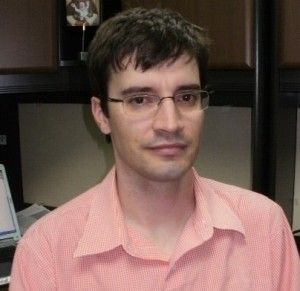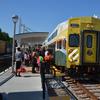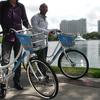Matthew Peddie appears in the following:
SunRail Exceeding Ridership Expectations: Officials
Tuesday, May 06, 2014
Orlando's new commuter rail service has been open for less than a week — and officials have already added an extra departure to the schedule. But the free rides are about to come to end.
Orlando's Bike Share Program to Roll Out in Spring 2014
Monday, October 07, 2013
Orlando's bike share program will be up and running next year -- timed to coincide with the launch of Central Florida's commuter rail service.
Deal Reached for New Rail Link Between Orlando and Miami
Thursday, October 03, 2013
WMFE - Orlando —
The private rail company All Aboard Florida says its on course to start a passenger rail service from Orlando to Miami by early 2016. The company announced Wednesday it had reached a deal to connect the rail service to Orlando International Airport.
PHOTOS: Space Shuttle Atlantis Now On Display in Florida
Friday, June 28, 2013
Space shuttle Atlantis made its debut at a $100 million specially built hangar at Florida's Kennedy Space Center Visitor Complex.
Passenger Rail Projects Proliferate in Central Florida
Monday, May 13, 2013
Orlando —
"We can’t depend on the old ways of doing things," says Harry Barley, the executive director of Central Florida’s regional transportation planning agency Metroplan Orlando.
"The old ways have typically been simply building wider roads and newer roads. We’ve got to look for more efficient ways of moving people." Florida may be known for aborting a high-speed rail project in 2011, but come 2014 and beyond, it may be a state of rail investment.
Orlando Airport First to Automate I-94 Customs Form
Thursday, May 02, 2013
International visitors flying into Orlando no longer have to fill out a paper I-94 arrival form.
Orlando On Track For Bike Share Next Spring
Wednesday, April 17, 2013
Orlando's transportation planning agency says the city could see a bike sharing system up and running by next spring, in time for Central Florida's SunRail commuter train, a program we reported on last fall. On Wednesday Metroplan Orlando's bike share working group got a look at bikes produced by one of the companies angling for a toe hold in Central Florida.
US Navy Could Use Blimps to Track Drug Submarines
Monday, April 08, 2013
The US Navy has been testing a blimp in Jacksonville Florida to see if it could be used as a submarine spotter off the coast of Central and South America.
Testing of the MZ-3A helium filled airship at Naval Station Mayport wrapped up Friday. Earlier last week, US Senator Bill Nelson (D- FL) took a ride on the blimp, which can carry a crew of 10
"I was really struck how maneuverable it is," says Nelson. "It can rapidly ascend and rapidly descend."
Bill Nelson after his blimp ride (photo by Katie Ross)
Nelson says the benefit of the blimp is fuel economy.
"The amount of fuel it takes to crank up a jet and just taxi out to the runway is the amount of fuel a blimp would use in an entire 24 hour period," he says.
The U.S. Navy's Fourth Fleet patrols the waters around Central and South America- shipping routes for traffickers of drugs, people and other contraband as part of Operation Martillo.
Sen. Nelson says smugglers use a variety of boats- some of them submersible.
"They ride right below the water’s surface, but they’ve gotten a lot more sophisticated than that. They’re building submarines."
The MZ-3A has a cruising speed around 45 knots. Navy spokesman Lieutenant Commander Corey Barker says the blimp wouldn't replace the fixed-wing jet and turbo-prop aircraft currently used in maritime surveillance.
"The blimp would not be responsible for pursuing a ship or fast speedboat," Barker says. "It would simply be responsible for detecting that and passing that information to our patrol units, our aircraft with our partner nations and the coastguard to intercept that ship."
USS Macon (U.S. Naval Historical Center Photograph.)
Airship technology is not new. The US Navy was flying rigid airships in the 1920s and 1930s. But Lt. Commander Barker says the surveillance equipment on board the MZ-3A blimp is state of the art.
He says the Navy will also be testing an aerostat, an unmanned balloon that could fly behind a ship to scan the surrounding sea.
"It's not as wide an area as a blimp, but it will have sensors that can detect and monitor illicit activity in the area," says Barker. Aerostats have been used by the military in Afghanistan and also in the 1980s by the US Coastguard to patrol the Caribbean.
U.S. Coast Guard ship with aerostat balloon (Photo: US Coastguard)
Object Lesson: How Sequestration Could Affect Small Airports
Thursday, March 14, 2013
Chocks Away- business jet traffic at Kissimmee Gateway Airport could suffer if the control tower closes (photo by Matthew Peddie)
Budget cuts brought about by sequestration could force the closure of more than 100 air traffic control facilities -- including control towers at smaller airports across the US.
Kissimmee Gateway Airport, which is just outside of Orlando, is on the list of towers which could be shut down April 7th. City leaders say that would put the brakes on one of the main economic drivers in the area.
“It’s an economic engine, not only necessarily because of what happens on the field, but also what happens adjacent to it," says Mayor Jim Swan. He says the economic impact of the airport is estimated around $100 million a year. Swan says losing the tower will make it tough to market a $3.2 million dollar business airpark which is being built with state and local funds.
A large part of the airport’s traffic includes business jets bringing people to functions at nearby Disney World and conventions on Orlando's International Drive.
Last year the airport saw 129,000 departures and landings from a mix of business jets, and propeller planes. Aviation director Terry Lloyd says losing the control tower- which is operated under a contract with the Federal Aviation Administration- could decrease flights to under 100,000 a year.
"I think it's something that we have a lot of dread [about], and there are a lot of unknowns," he says.
He says having a tower to help manage traffic makes Kissimmee a more attractive destination for business jets.
"The corporate traffic- that's kind of on the top of their checklist, if there's an airport with a tower, that's where they go," he says. "And then if there's not a tower they make a decision- is it important enough for us to go in there, and a lot of it's driven by the aircraft insurance companies."
Aircraft operators also have fuel agreements at airports - like Kissimmee- that guarantee the price of aviation fuel if they land there. Lloyd says those agreements could also be jeopardized by the loss of the tower.
Other airport users say they're concerned about safety. John Calla, vice president of operations for Italico Aviation-- a company that plans to import and assemble light sport aircraft at Kissimmee -- says he's worried about the mix of traffic if there's no tower. "You see the jets that take off here and the speed they operate," says Calla. "You get a smaller aircraft that's used to flying about 60 miles per hour, integrating with something of that size, and you could get some conflicts.
Calla says the tower is important to separate and sequence the arrival and departure of planes. "They know the speed of the aircraft and they know how much to sequence it so traffic flow is not impaired. It also improves the safety as well."
Florida Congressman Alan Grayson has written to Transportation Secretary Ray LaHood and the FAA urging them to consider the impact of closing the tower.
Toll Lanes Touted as Congestion Fix for Central Florida's I-4
Friday, March 08, 2013
Artist's impression of the I-4 Ultimate project through Orlando (Image courtesy of Florida Department of Transportation)
"We love Orlando, we love Mickey Mouse, we love Walt Disney, Universal, the Church Street Facilities, that great mall -- Millenia Mall, but dadgum that I-4, that's a headache," Florida Department of Transportation Secretary Ananth Prasad told journalists in Orlando this week.
"We're going to fix that headache."
The Florida DOT is moving ahead with plans for the I-4 Ultimate project- a $2.1 billion dollar fix for I-4. The state's prescription includes adding toll lanes to a 21-mile stretch of the interstate running through the heart of Orlando. The department aims to begin construction in 2015 and complete it by 202o.
Prasad said four so-called "managed lanes" would be added to the interstate, leaving six lanes toll free. Tolls would be higher during heavy congestion periods and lower when traffic is light.
“We use tolls to only keep a certain number of people in the managed lanes so we can keep them going at 50 miles an hour," he said. "Say if I-4's ‘general purpose’ lanes – the toll-free lanes – are congested and you only charge a quarter, everybody’s going to be on it, and now you got another two lanes of gridlock. So what you do is you use tolls as a way to manage capacity coming in to the express lane.”
Prasad conceded there is a downside to building the extra lanes.
"There's going to be inconvenience- you're talking about $2 billion worth of work in a very constrained corridor- albeit a long corridor- getting done over five years. It's a lot of work."
However, Prasad said a similar $1.3 billion expansion project is successfully underway on South Florida's I-595. He said travel times along that stretch of road-- roughly 10 miles -- have only increased by an average of five minutes because of construction.
The state is putting up about half the $2.1 billion dollar cost of the I-4 Ultimate project and courting private investment to foot the remainder of the bill. Under a public-private partnership agreement with the state, private firms would also maintain and operate the toll lanes for a fixed length of time.
Prasad said the public private partnership allows Florida to take advantage of low interest rates and construction costs.
"What the state gets is delivering a project 20 years in advance," he said.
"If we were to do this project on a regular pay-go mechanism, we would be building it for the next 20 or 25 years and chasing congestion like we always do."
Gregg Logan, a managing director at the real estate advisory firm RCLCO's Orlando office, says the I-4 upgrade will help the local economy.
"You don’t want businesses that are here already and thinking about expanding saying, 'Gee, do I want to stay here and deal with this gridlock'- or companies that might be thinking about coming and bringing jobs. We want them to be looking at [Orlando] as a good place to invest because we have our act together."
And he says Florida has to look for new ways to fund infrastructure - with a combination of local government funding, private investment and user fees- because federal government dollars are limited.
"Like it or not that seems to be a collective decision we’ve made as a society for that’s how we’re going to fund infrastructure," says Logan, who adds he's worried the US is falling behind other countries in transportation infrastructure.
"When you look around the world right now and you look at where big rail projects and transit projects are being done, you find that’s in China Brazil, the Middle East," says Logan.
"We’ve sort of forgotten that part of what has made us great and enabled us to have the growing economy we have is that we made these investments in infrastructure. Now we’ve taken that for granted."
The Florida DOT is promoting I-4's managed toll lanes as one part of a multi-modal transport system that could also include bus rapid transit to complement Central Florida's SunRail commuter train. SunRail is slated to begin service in 2014, while private rail companies are also talking about an Orlando to Miami service and a maglev rail linking Orlando International Airport with the Orange County Convention Center.
Eric Dumbaugh, the director of Florida Atlantic University's School of Urban and Regional Planning, supports the addition of managed lanes to I-4. The challenge for Florida, he says, is to develop viable alternatives to driving.
"Our transit system is inadequate in all of our metropolitan areas: it doesn’t take us where we need to go, our development doesn’t link up to it as well as it should, so we’re trapped in our cars."
But Dumbaugh says he's optimistic about Florida's ability to develop a truly comprehensive transportation system, because a new generation is now demanding alternatives to the car.
"You survey millennials- they don’t want to drive," says Dumbaugh, who highlights the efforts of a group of Florida Atlantic University students to set up a transit themed installation in Miami this weekend.
A Year After the Trayvon Martin Shooting, Florida City Examines Urban Design
Thursday, February 28, 2013
Trayvon Martin memorial in Goldsboro, Sanford (photo by Matthew Peddie)
Last year the shooting of unarmed black teenager Trayvon Martin thrust Sanford to the center of international attention -- and spurred a conversation about how urban design and public space shape civic behavior.
Now, Sanford is searching for a new vision for its future. The city has established Imagine Sanford, a project aimed at creating a solid identity for the city -- and a plan for how to get there. The 13-member steering committee is made up of community leaders who meet monthly while the plan is being formulated.
Sanford Mayor Jeff Triplett says although the project started in January 2012, since Trayvon Martin's death the pressure has been on to get the project moving.
Mayor Jeff Triplett on the Jumbotron (right) at a 2012 rally for Trayvon Martin
Although Sanford has an enviable downtown, he says, more needs to be done to link up the distinct areas of the city, including the historic African American neighborhood of Goldsboro.
"We haven't really done a very good job of making Goldsboro part of the city, so to speak," he says.
"You've got historic Goldsboro Boulevard- we want to take that and do the beautification on through 13th [street] which ties that in to [US Highway] 17-92 and what's happening on the east side of town too."
Some of the other proposals for the city include welcome signs and a system of hiking and cycling trails through Sanford and around Lake Monroe.
Triplett says he wants to make sure the trail system connects to the SunRail commuter train station.
"Some people say we're disadvantaged because of the placement of our SunRail [but] we're kind of blessed in a way because we've got a blank slate out there."
Triplett says the vacant land around the station will allow for new development linked to the rail- including shops and apartments.
"We've got a great opportunity over the next ten years- we've just got to make sure we do it right the first time."
Listen to a an interview with Sanford Mayor Jeff Triplett here.
Florida's SunRail Is On Pace to Launch in 2014, Gets Another $87 Million in Fed Funds
Friday, February 22, 2013
Federal Transit Administrator Peter Rogoff at Friday's SunRail announcement (photo by Matthew Peddie)
Another infusion of federal cash is keeping central Florida's SunRail project on track to open in 2014.
Federal Transit Administrator Peter Rogoff, speaking on behalf of transportation secretary Ray LaHood, paid a visit to a Florida Hospital in Orlando, where one of the stops for the 61 mile long SunRail line is being built. Rogoff was joined by local leaders, state department of transportation officials and Florida lawmakers including U.S. Senator Bill Nelson and U.S. Rep. Corinne Brown.
Rogoff announced the federal government would make $87.3 million available in funding for SunRail, bringing the FTA's investment to date in the Central Florida commuter rail line to $148 million. The Federal government has agreed to pay $178.6 million overall in New Start funds towards construction of the 32-mile long first phase of the line, about half the capital cost.
"We make incremental payments based on the progress of the project," Rogoff said. "They're making great progress, they're ready to spend that money, they're ready to keep these people on the job."
Rogoff highlighted the rail line as a jobs engine, which has already employed 800 people to work in construction.
"But what we're really excited about is all the additional jobs that are coming in from the economic development along the line," he added.
The Florida hospital station is at the heart of a 176 acre "health village" where the hospital is developing medical research offices, apartments and shops.
SunRail officials say there are more than two dozen retail, office, government and residential development projects associated with stations along the rail line, representing $1.6 billion in investment.
"We are here to celebrate the continuing completion of a transportation system for the metro Orlando area that is putting us into the 21st Century," said Senator Bill Nelson (left) "The only thing lacking is the high speed rail which we had $2.5 billion dollars on the table of the federal share," he added. (photo by Matthew Peddie)
Rogoff also talked about the need for additional spending on roads and other infrastructure in Florida-- particularly to fix up hundreds of bridges, highlighting president Obama's call for a $50 Billion infrastructure plan. "If that $50 billion dollars goes through, you're going to see more investment around here, not just on this type of rail project but on highway and sea port projects that will keep the economy of Florida going."
Asked whether sunshine state might see federal funds in the future for high speed rail, Rogoff said "that is going to depend a lot I believe on the leadership of Florida."
Florida's Governor Rick Scott famously turned down federal money for a high-speed rail line from Orlando to Tampa in 2011.
Meanwhile, SunRail officials say the first phase of the commuter rail line, a 32 mile long stretch from DeBary to Sand Lake Road, will open in 2014.
Making Orlando's Streets Safer for Pedestrians
Tuesday, February 19, 2013
Pedestrians fare better crossing low-speed streets like this one in Thornton Park, Orlando. But high-speed, multi-lane roads are more of a challenge. (Photo by Matthew Peddie)
For years, Orlando has ranked among the most dangerous metro areas for pedestrians in the nation, with roughly two injuries per day and one fatality a week. Now a coalition of pedestrian advocates, law enforcement, local government and health agencies is trying to change that, with a program called Best Foot Forward. And eight months after the program launched, there are some signs of improvement.
Transportation experts say there are three steps needed to make the roads safer for pedestrians: education, enforcement and engineering. Orlando is trying all three, but it still has a long way to go to change the culture for people on foot.
“It’s pretty abominable,” says Bill Carpenter, a volunteer collecting data for the Best Foot Forward Program. He says pedestrians haven’t had much of a voice in Central Florida until now.
Carpenter is monitoring how drivers behave at crosswalks. A pickup truck approaches the intersection of Rollins street and Camden road in Winter Park. Carpenter steps cautiously into the road stretching out one hand to point down at the crosswalk. The driver doesn’t stop.
Bill Carpenter has been monitoring "voluntary yield rates" for drivers at Orlando crosswalks (photo by Matthew Peddie)
“Motorists reactions run the gamut," says Carpenter. "There’s some that begrudgingly stop, then others that wave back at you and say thanks for waiting there for me and go on.”
This dangerous dance is repeated daily all over the city by other pedestrians.
In East Orlando, a restaurant worker called Tony makes his way to a bus stop on South Semoran Boulevard, near Curry Ford Road.
“This intersection here, it’s crazy," says Tony. He says drivers aren't courteous. "No. They’d rather run you over.”
Badly injured pedestrians go to the Orlando Regional Medical Center, which is part of the Best Foot Forward Coalition. Last year doctors at the center treated over 400 patients who’d been hit by cars.
But there are signs the education campaign is starting to have an effect, says project manager Brad Kuhn.
“On those roads at 35 miles an hour and less, we’ve been able to take the yield rate from about one in eleven to approaching one in three.”
That means at some of the 18 crosswalks being monitored in Orlando and Orange county, more drivers are yielding now for pedestrians than they were six months ago.
Kuhn’s organization, Bike Walk Central Florida, has reached out to 88,000 households to promote pedestrian safety, and 11 Orange County elementary schools are teaching a pedestrian safety syllabus. But, says Kuhn, high-speed roads are still a problem.
“By the time you see the pedestrian, you’re already past them," he says, "which is unfortunate, because on a 40-mile-an-hour road, your chance of survival if you get hit is 15 per cent.”
Enforcement is used to back up the education campaign. Last year police and sheriff’s officers handed out more than 1,200 tickets and arrested 20 drivers for failing to yield at crosswalks.
Orlando Police sergeant Jerry Goglas says some drivers try to blame the pedestrian. “They say: “did you see the pedestrian jaywalking, why is the pedestrian in the road?” Some of them are not understanding once a pedestrian is in a marked crosswalk the driver has to yield.”
Transportation for America's map showing pedestrian fatalities around Orlando 2000-2009. (Image from the 2011 report 'Dangerous by Design')
Best Foot Forward is trying out low-cost engineering like signs and road markings-- but the coalition is also interested in something called the Rectangular Rapid Flashing Beacon.
It’s a small box mounted on a pole at a crosswalk. When activated, a bright LED light flashes towards the eyes of approaching drivers, signaling them to stop. In St. Petersburg, on the other side of the state, these beacons have helped cut the pedestrian accident rate in half over the last ten years.
Pedestrian advocate Bill Carpenter thinks these beacons could help in Orlando, but he says changing drivers attitudes is a long term project. “I’d hate to venture a guess, but it’s going to take longer than six or 12 months. It’s going to take a lot.”
The Florida Department of Transportation is also engaged around the state trying to make the roads safer and it’s rolling out a pedestrian awareness campaign focusing on ten counties with high pedestrian crash rates. In the meantime, Best Foot Forward hopes its early success will eventually translate into fewer pedestrians winding up in hospital.
Listen to an audio version of this story here. And follow Matthew Peddie on Twitter here.
NASA's Moon Mining Robot
Monday, February 04, 2013
NASA's RASSOR (Regolith Advanced Surface Systems Operations Robot) (photo by Matthew Peddie)
In a building at the Kennedy Space Center, Florida, about 40 engineers and scientists are tackling the practical challenges of space exploration -- like designing astronaut clothing for long missions, converting trash into fuel, and harvesting extra-terrestrial resources.
"It's really a return to NASA's roots, the very early days of how NASA designed new technology" says Jack Fox, Chief of the Surface Systems Office at Kennedy Space Center. "We believe in a hands-on approach: just try something out, and if it works, great. If it doesn't, put it aside and try something different."
Swamp Works- NASA's technology incubator at Kennedy Space Center (photo by Matthew Peddie)
The Swamp Works team is housed in the refurbished Apollo flight crew training building, where astronauts once familiarized themselves with the lunar module and learned how to use the lunar rover. Scientists are now trying to solve some of the problems faced by those astronauts -- like dealing with space dirt.
"Dust got everywhere. It clung to everything," says Fox.
On one side of the building scientists are developing technology to banish dust electronically.
And in the Granular Mechanics and Regolith Operations lab, engineers are figuring out how to deal with the sandblasting effects of rocket exhaust during landing and lift-off on the moon and other planets. They're also building a machine to excavate space dirt, or regolith. NASA one day hopes to send astronauts beyond the moon, to an asteroid or Mars, and the Swamp Works team is developing a robot that can excavate other planets for water and other resources.
The RASSOR (Regolith Advanced Surface Systems Operations Robot) looks like a small tank. At each end is a fearsome toothed drum, used to scoop up the regolith. It can also raise and lower its arms to climb over rocks.
Drew Smith, who helped design RASSOR, explains the counter-rotating drums would allow the robot to dig on another planet like the moon.
"Since we don’t have a really large mass on another planet we have to be able to cancel out the excavation forces or it would just spin its tracks and not go anywhere."
The robot weighs about 180 pounds, but on the moon that's only about 30 pounds of force.
The engineers are building a regolith test bed -- essentially a giant sand pit -- which they'll fill with 120 tons of "simulant" or imitation space dirt, so they can test the robot.
Philip Metzger, NASA physicist (photo by Matthew Peddie)
Philip Metzger, a physicist at the Regolith Operations Lab, says harvesting resources on other planets could lighten the load of spacecraft blasting off from earth. "By using the resources of space -- of the moon and the resources of Mars, we can reduce the mass of a Mars mission by a factor of between three and five," says Metzger.
NASA aims to eventually send a version of the RASSOR into the craters of the moon to excavate lunar ice deposits. Metzger says anything they design to work on the moon should also work on Mars -- although operating the robot remotely poses a problem: "On the moon there's only a 2.7 second time delay, so you can tele-operate, but on Mars it’s too far of a distance to tele-operate. So robotic autonomy is one of the key technologies we’re trying to develop," he says.
Companies like Caterpillar are interested in robot autonomy for terrestrial mining. "Mining’s moving into places humans can’t go here on earth," says Metzger, adding that space mining companies have also expressed an interest in licensing the technology.
NASA's Orion spacecraft under construction at Kennedy Space Center (photo by Matthew Peddie)
Meanwhile, in a separate building at Kennedy, NASA employees and Lockheed Martin contractors are assembling the spacecraft designed to take astronauts to an asteroid, Mars and beyond. The green welded aluminum pressure capsule of the Orion crew module is being transformed into a functioning spacecraft inside the Operations and Checkout building. Orion's first unmanned foray into space is slated for September 2014.
Mica Gets Transportation Subcommittee Posts
Wednesday, January 23, 2013
John Mica (photo by Matthew Peddie)
Representative John Mica (R-FL) will retain some influence in helping set transportation policy, even though Pennsylvania Congressman Bill Shuster has taken over as chair of the powerful House Transportation and Infrastructure Committee.
Mica was appointed to three subcommittees: Highways and Transit; Railroads Pipelines and Hazardous Materials; and Economic Development, Public Buildings and Emergency Management. He was also named chair of the subcommittee on Government Operations under the House Oversight and Government Reform Committee.
The Winter Park Republican says he's proud of his legacy as chair of the Transportation Committee.
"My replacement is fortunate in that we passed a highway bill, we passed an FAA bill that was stalled for many years under the Democrats, we passed a Coast Guard reauthorization, we passed pipeline safety legislation, so most of the major bills have been passed," he says. "So [Shuster] has time to reassess and then move forward with a highway bill and find a responsible way to go beyond the next two years. "
But Mica says it will be a challenge to try to fix congested and crumbling highways. "Unfortunately it’s almost impossible to increase gas taxes, and that doesn’t really even solve your problem because people are using even less of the traditional gasoline."
"You have alternative fuels, you have plug in cars, and you have cars going much further on one gallon of gas."
One source of revenue included in the current transportation bill allows for extra toll lanes to be built on existing interstates like I-4.
Mica says Amtrak -- which he labels a "Soviet style passenger rail system" -- also needs reform, and he favors allowing private operators to run the passenger rail system.
Meanwhile, Mica says he’s excited about the prospect of private passenger rail starting in the state - with All Aboard Florida proposing a Miami to Orlando service beginning in 2015. "It'll be a project that actually will make money and pay taxes with the private sector," he says. "That's the way we need to be going with passenger rail service across the country."
Threatened Tortoises Make Way for Central Florida Toll Road
Friday, January 04, 2013
A gopher tortoise captured from a burrow on the Wekiva Parkway site (photo by Matthew Peddie)
Construction of a 25-mile long toll road that will complete a beltway around Orlando is due to begin in February, but before building on the Wekiva Parkway can start, threatened gopher tortoises have to be moved out of the way.
The $1.7 billion roadway project is being showcased as an example of careful transportation planning through an environmentally sensitive area. In addition to relocating threatened species, the project will include fencing and wildlife bridges to minimize the risk of animal- vehicle collisions, and much of the roadway will be elevated.
About 260 gopher tortoise burrows have been identified around the first few miles of the parkway slated for construction. Backhoes are used to scoop away the bulk of the dirt, taking care not to disturb the burrow itself. The tunnel is marked with a long PVC pipe so the backhoe operator doesn't dig too deep.
Biologist Joel Johnson (left) directs a tortoise excavation (photo by Matthew Peddie)
Every few feet the backhoe driver stops, and a biologist - like environmental consultant Joel Johnson - climbs into the crater to dig with a shovel
"When it gets down to the more intricate part of the excavation, you’ll dive in with an arm to pull the tortoise out," says Johnson.
"At some point it’s a personal touch. The iconic thing is this backhoe here digging these huge holes in the ground, but the action is really in a couple of feet, you know, five feet around that burrow."
Gopher tortoises are powerful diggers. A typical burrow could extend 30 feet lengthwise and slope down to a depth of 25 feet.
After digging down a few feet, the backhoe driver stops to allow some manual shovel work (photo by Matthew Peddie)
Getting the tortoises out isn't easy.
"They are surprisingly strong, like most crevice dwelling and burrowing animals, and once they get in there and decide they don't want to come out, it becomes a matter of leverage," says Johnson.
"We have ones that dig as fast as we are. We're chasing them," he says.
"And then sometimes they come up and they look like a zombie coming out of a grave, out of the dirt right after you take a swipe."
Two backhoes, two shovel wielding biologists... but no sign of a tortoise in this burrow (photo by Matthew Peddie)
The gopher tortoise is important to Florida's ecology because other animals use its burrow to shelter and find food.
"They call [the gopher tortoise] a keystone species," says Mike Dinardo, the environmental coordinator for the project.
"That burrow provides refuge for others escaping fire, maintaining humidity and escaping heat."
The gopher tortoises' room mates include the indigo snake, the gopher frog and the pine snake, as well as crickets and other insects.
Insects like this one share the gopher tortoise burrow (photo by Matthew Peddie)
The gopher relocation project started mid December, so far capturing more than 40 tortoises. It could take another few weeks to dig up the remaining burrows.
Once the animals get a health check up they’ll be moved to a ranch in Okeechobee County, South Florida.
Environmental coordinator Mike Dinardo and the tortoise containers (photo by Matthew Peddie)
Florida Port Directors Warn of Ripple Effect If Dockworkers Strike Goes Ahead
Thursday, December 27, 2012
(image courtesy of Florida Seaports Council)
(Orlando, Fla. — WMFE) Florida port directors held a conference call with Governor Rick Scott Thursday to warn about the impact of a looming dockworkers strike. The dockworkers union is prepared to strike unless there's agreement on a new contract before Saturday night, when an extension on the old contract expires.
A strike by International Longshoremen's Association dockworkers would disrupt the movement of container cargo from about 60 ships a week at Florida ports.
Port Miami director Bill Johnson says a dockworkers' strike would also affect thousands of other jobs. “It isn’t just six thousand people working on my port today, it’s tens of thousands of people working in South Florida and throughout the state," he said. "It isn’t just Miami impacted as a port, it’s Orlando, it’s Cleveland, Ohio. I mean this is an impact nationwide.”
Port Canaveral’s director Stan Payne said disruption to the transportation supply chain would reach far inland. "Our entire transportation structure in which billions of dollars has been invested, (will) simply cease to function," he said, "at huge cost to our economy and the jobs."
Florida’s 15 deepwater ports account for about 550,000 jobs and generate $66 billion dollars in economic activity.
Governor Scott has asked President Barack Obama to use a federal law-- the Taft-Hartley Act-- to stop the strike if a deal isn’t reached by the Saturday deadline.
The dockworker's union, the International Longshoremen’s Association, is continuing bargaining talks with the US Maritime Alliance, which represents the ports and shippers.
Year in Review Florida: Rail Blooms, Shuttles Retire, Mica Moves on
Tuesday, December 25, 2012
(photo by NASA/Bill Ingalls)
The top transportation stories from WMFE in Central Florida show the resilient support for ambitious new rail projects, and for car culture. Plus, stunning pictures of huge spacecraft are a big hit.
New Plans Sprout in Wake of Scuttled High-Speed Rail
While Central Florida's SunRail commuter train chugged towards a goal of beginning service by 2014, private rail companies also laid out ambitious plans for new passenger services in Florida.
Florida East Coast Industries floated plans for a regular train between Miami and Orlando International Airport. FECI is still working to get rights of way for the final leg of the service, dubbed All Aboard Florida, which it aims to have rolling by 2015. The company says no public funding will be needed to pay the estimated $1 billion to get the service up and running. And once it starts they say it will be a viable alternative for road weary business commuters between South and Central Florida, as well as tourists who don't want to hop in a plane for the 200 mile trip.
Another company is also pushing plans for a high tech elevated monorail -- a magnetically levitating train to run from Orlando International Airport to the Orange County Convention Center. Despite some local skepticism and past struggles to make his maglev rail a reality, American MagLev Technology chief executive Tony Morris appears to have won over the Orlando area transportation planning agency, which has given AMT the go-ahead to move forward with its plan.
Sunrail is also stirring talk of a cycling renaissance in Central Florida, with bike share part of the mix.
But Cars Still Rule the Roads ...
In the meantime the automobile still rules the road in Orlando- which can pose problems for seniors who've given up their car keys. Urban planners are optimistic about the train's potential to spark a rethink about where people live and how they commute in Central Florida.
For motorists traveling through the Orlando metro area a choice often presents itself: pay to use toll roads and (theoretically) reach the destination quicker, or brave the traffic and lights and save on tolls. WMFE put the theory to the test in a race to the airport. (Ed note: for the full fun of this story, listen to the audio version)
Florida Loses a Key Political Post
Orlando political heavyweight John Mica, the chair of the U.S. House Transportation Committee staved off a challenge from Tea Party favorite Sandy Adams in a tough primary election battle, then cruised to victory against his Democrat rival in November. After indicating he'd seek a term-limit waiver to stay on as chair of the House Transportation Committee, Mica relinquished his grasp on the post, endorsing fellow Republican Bill Shuster from Pennsylvania for the spot. Mica hasn't said what other committees he might be in line for.
Space Travel Enters a New Era
The Mars rover sent back stunning high-res images from of the red planet, marking a new highpoint of excitement in space exploration. But here on earth, the Kennedy Space Center was moving on and bidding farewell to the last generation of spacecraft. NASA retired its shuttle fleet. Endeavour flew to California, Discovery piggy backed up to Washington DC and Atlantis rolled down the road to the nearby visitor center. Meanwhile other equipment at Kennedy Space Center is getting an overhaul for a new era of deep space exploration.
NASA may have closed down its shuttle program, but commercial companies are ramping up efforts to replace the iconic orbiters. Space Exploration Technologies celebrated a successful demonstration flight of its Dragon capsule to the International Space Station- the first commercial craft to do so- followed a few months later by the first contracted supply mission to the orbiting outpost. Engineers at the California based SpaceX are working to figure out what caused one of the engines to shut down on the launch, but the capsule still made it to the ISS with cargo intact- including ice cream.
BONUS STORY: While the nation debated the tragic death of a Trayvon Martin in Sanford, FL WMFE explored the backdrop of where the shooting took place.
Orlando MagLev Plan Gets Tentative Approval
Monday, December 17, 2012
Magnetic levitation concept drawing (Image courtesy of American Maglev Technology Inc.)
A private company aiming to build a 40-mile long, $800 million dollar magnetic levitation rail line through Orlando has the green light to move forward with its plan.
American Maglev Technology Inc. says the monorail would be a first for the U.S.
The transportation planning agency Metroplan Orlando gave its conditional approval to phase one of the plan last week -- a 15-mile elevated line connecting Orlando International Airport and the Orange County Convention Center.
The first phase would cost $315 million. MetroPlan's approval clears the way for the Florida Department of Transportation to solicit bids for use of the public right of way along the proposed route.
Tony Morris of American Maglev Technology Inc (AMT) says no public money would be needed to fund the project. According to AMT presentation materials, the company's system would cost $20 million per mile to build, compared to $70 million for other maglev systems.
MetroPlan wants a technical assessment to ensure the technology is safe, and it wants a request for proposals issued to see if there are competing plans before proceeding further.
MetroPlan executive director Harry Barley says the Florida Department of Transportation will carry out the technical assessment.
"This is a new technology, there is a test track and the [AMT] team has already gone through a great deal of testing on their own," says Barley. "But we feel there needs to be some additional work to review what they've done and perhaps build upon that before we're really confident the technology is appropriate."
Lease agreements also need to be negotiated to acquire public right of ways for the project.
Barley says those details will have to be worked out amongst the various agencies, including the Greater Orlando Aviation Authority, the Orange County Expressway Authority, Orange County and the City of Orlando.
"The step that was taken with all those people present and voting to move ahead, I think reflects the collaborative nature on which this project can move forward."
AMT chief executive Tony Morris began working on a magnetic levitation rail system in Volusia County in the 1990s-- but that project didn't progress beyond the test phase.
It's Toll Roads vs. Surface Streets in Race to the Orlando Airport
Wednesday, November 14, 2012
At the starting line, outside Orlando City Hall
Thursday morning, 9am: two law-abiding drivers, two routes to the airport, one winner.
WMFE reporter Matthew Peddie and news director Mark Simpson wanted to figure out the fastest route the airport from downtown Orlando. In a thoroughly unscientific experiment, they put two kinds of roads to the test. The toll road to the airport tacks on distance but promises a speedier ride. Surface roads are free and more direct -- but are studded with traffic lights.
Whose route was victorious? Listen to the radio story, below.



































